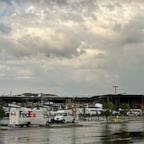Spinal Injuries up Among Troops
Doctors are concerned about impact of roadside mombs on blast-resistant vehicles
Bagram, Afghanistan, Nov. 4, 2009— -- Afghan insurgents are using roadside bombs powerful enough to throw the military's new 14-ton, blast-resistant vehicles into the air, increasing broken-back injuries among U.S. troops.
Doctors at the U.S. military hospital here say more than 100 U.S. servicemembers have suffered crushed or damaged spinal columns from being thrown around inside armored Mine Resistant Ambush Protected (MRAP) vehicles in the last five months.
This "significant increase" in spinal injuries was not seen in the Iraq war, says Air Force Col. Warren Dorlac, director of trauma care for both conflicts. One in five wounded service members evacuated from Afghanistan this summer and early fall suffered a spinal injury and at least 14 were left paralyzed or with loss of sensation, says Air Force Lt. Col. Dustin Zierold, a surgeon and the hospital's director of trauma care.
"Whatever the G-force (of the roadside bombs), it is very high and very destructive," Zierold says.
Medical officials here are concerned about whether seating, harnesses and flooring in MRAPs adequately absorb the force of blasts, Zierold says. He says a doctor in Kandahar is trying to design a seat that would guard against spinal injuries.
More research is needed to improve seating and flooring designs, said Marine Brig. Gen. Michael Brogan, director of the Pentagon's MRAP program. "In future vehicles, that will be the key to survivability," he says.
The MRAPs are the military's chief response to the No. 1 killer of U.S. troops in Iraq and now in Afghanistan -- roadside bombs. More than 3,500 of the $1.4 million vehicles are in Afghanistan. Brogan said that insurgents are building larger bombs to overcome the MRAP's armor and the V-shaped hull, which carries the force of an explosion away from the center of the vehicle.




